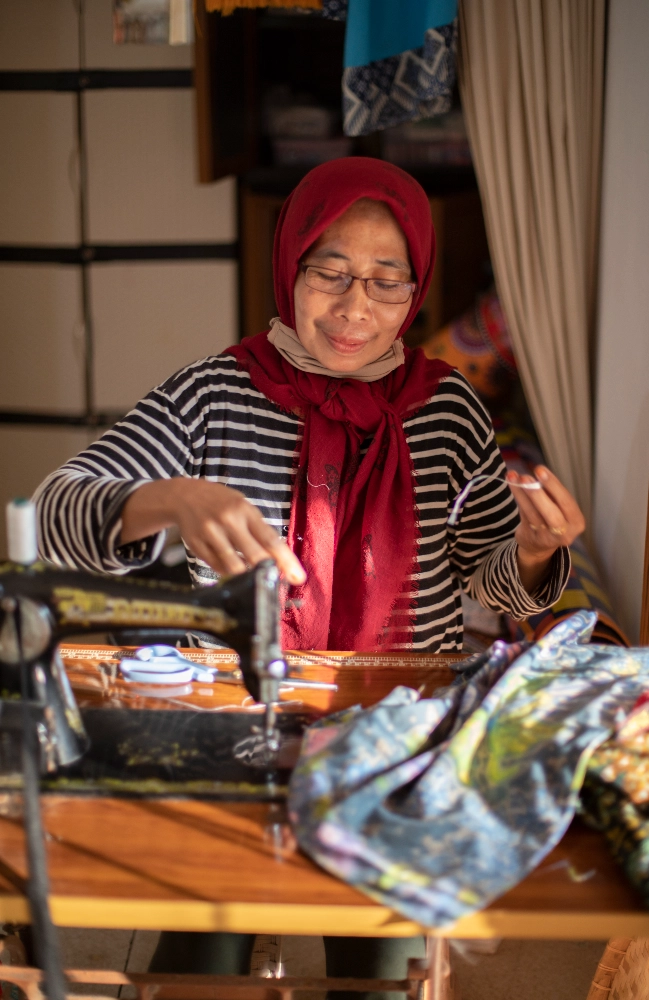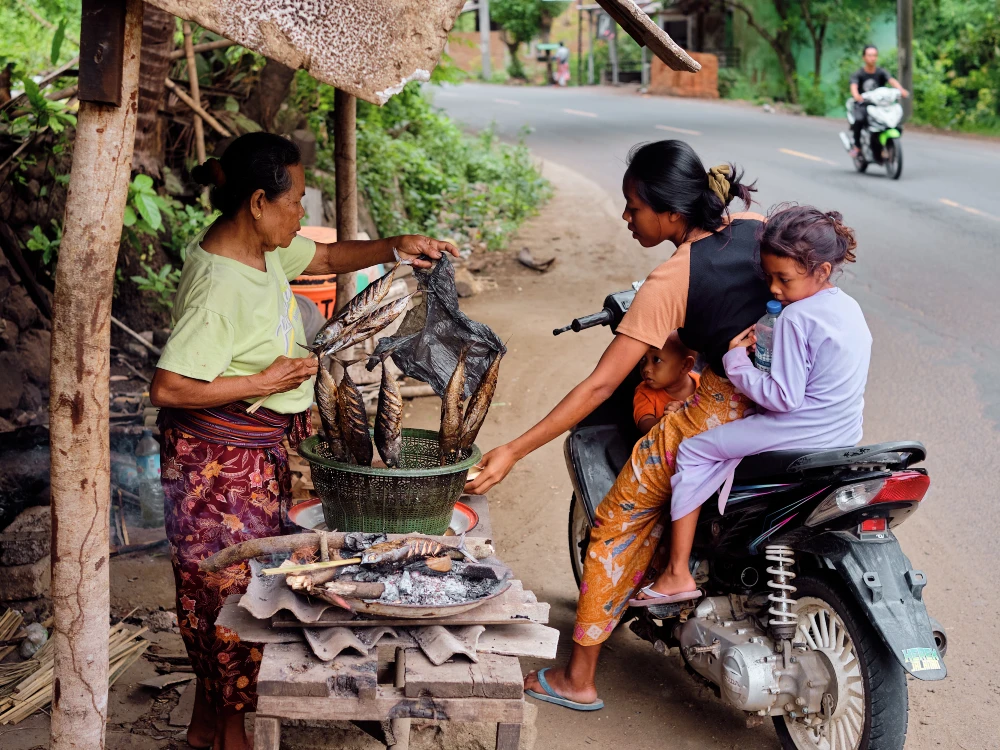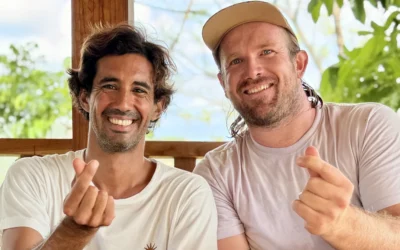Surf, sun and yoga. Lombok has all the island essentials. But if you’re the kind of traveller who wants a little more culture with your smoothie bowl, stick around.
Beyond the beach lies a culture as vibrant and layered as a handwoven songket.
We’re talking about the Sasak people… the island’s indigenous majority and the heartbeat of Lombok.
We have workshops and excursions for guests that dive into the nuances of Sasak culture. But we thought we’d also write a tell-all guide too.
Enjoy!



1. Visit a traditional Sasak village
Want to get a snapshot of Sasak culture and everyday life? Sasak villages like Sade (only 15 minutes from Xanadu) and Ende still hold onto age-old traditions. Think:
- Thatched houses made from bamboo and buffalo dung (seriously… it keeps things cool)
- Rice barns on stilts called lumbung
- Narrow zig-zagging pathways connecting villages
- Locals who are happy to share stories about their customs. Especially marriage rituals like Merariq (yes, they still practice symbolic bride “kidnapping”)
Just keep in mind that these aren’t theme parks. They’re working communities. So walk gently, be curious and leave only footprints.
2. Watch Sasak women weave their magic
Weaving isn’t just craft here. It’s a rite of passage. In villages like Sukarara, Sasak women are masters of ikat and songket weaving. You’ll see:
- Girls learning to weave before they can marry
- Bold patterns loaded with cultural meaning
- Gold and silver threads glinting in the sun
- Friendly locals inviting you to try the loom (good luck!)
Buying direct from the weaver supports the community and keeps these ancient skills alive. You can also check out Nine-Nine. More on that below!
3. Taste the real Lombok
Love a good food journey? Sasak cuisine is fiery and earthy and totally addictive. Some of our favourite must-try dishes include:
- Ayam Taliwang: sweet grilled chicken with a spicy coconut sauce
- Pelecing Kangkung: water spinach and bean sprout salad with tangy tomato-chilli dressing
- Beberuk Terong: spicy eggplant salad with vegetables
For the hands-on foodie, take a local cooking class. Many are run by families and teach you how to:
- Grate fresh coconut (not as easy as it sounds)
- Wrap food in banana leaves
- Use traditional tools for grinding spices
And yes, we know what you’re thinking. Fortunately, you do get to eat everything you make.
4. Feel the beat with Gendang Beleq
Gendang Beleq means “big drum”. And you’ll feel it in your chest before you even see it. Often performed during ceremonies, weddings and festivals, these performances feature:
- Drummers playing in pairs
- Accompanying dancers and musicians
- Traditional costumes and serious big drum energy
It’s loud, rhythmic and hard not to smile through the whole thing.
5. Discover the Sasak language (and its many dialects)
The Sasak language isn’t just one language. It’s a patchwork of dialects depending on where you are on the island. You might hear:
- North Sasak (Kutó-Kuté)
- Northeast Sasak (Nggetó-Nggeté)
- Central Sasak, Central East, Central West and Central South Sasak (Menó-Mené, Ngenó-Ngené, Meriaq-Meriku)
Each region has its own twist. Kind of like accents and slang.
Most locals also speak Bahasa Indonesia, but learning a few Sasak words (like “tampiasih” for thank you) will win you major respect.
Try it!
6. Celebrate culture with festivals and rituals
The Sasak people know how to throw a celebration. Keep your eye out for:
- Bau Nyale Festival (Feb/March depending on full moon): locals gather sea worms said to be the reincarnation of Princess Mandalika
- Peresean: stick-fighting duels with rattan canes and shields
- Rudat Dance: martial arts meets dance, performed to welcome guests
- Merariq: mentioned earlier. It’s a traditional (and symbolic) bride abduction ceremony
- Nyongkolan: when the bride and groom are paraded together like a king to the bride’s house
7. Go beyond tourism with Nine-Nine
Remember when we mentioned Nine-Nine? Well, if you’re after the most meaningful cultural experience on Lombok Island, this outfit should be at the top of your list.
Nine-Nine, which is run by our good friend Lulu, is a community-based initiative that brings you face-to-face with real Sasak culture.
It’s hosted by the people who live and breathe it every day. And created by local changemakers. At their core, Nine-Nine offers immersive experiences that prioritise connection, cultural respect and local empowerment.
You won’t find scripts or rehearsed performances here. Instead, you might:
- Walk through Central West Sasak villages with a local elder
- Learn to cook using family recipes in a traditional bamboo kitchen
- Share a meal while swapping stories with your hosts
- Try your hand at weaving, farming or preparing offerings
Every experience is rooted in local tradition and designed in collaboration with the indigenous people who host it. And it goes both ways.
While you learn about Sasak language, food, beliefs and family life, your presence directly supports communities through ethical income and skill-sharing.
If you’re looking for something real (and not staged or scripted), this is it.
8. 6 Quick Sasak facts to impress your travel buddies
- The Sasak people make up the majority of Lombok’s population
- They live mostly in the central and southern parts (especially Kuta, Praya and Sade)
- Islam is the dominant religion, but traditions like Wetu Telu mix Islam with older beliefs
- The island is part of Indonesia’s West Nusa Tenggara Province near Bali
- Sasak language has at least five main dialects
- You’ll find their cultural roots in their houses, music, clothing, ceremonies and oral tradition
9. Tips for traveling respectfully
- Dress modestly in villages and temples (cover shoulders and knees)
- Ask before taking photos
- Use local guides to avoid misunderstanding cultural boundaries
- Buy direct from artisans whenever possible
- Make Nine-Nine your first port of call for a great intro to Sasak culture
- Be curious but humble… you’re a guest here
FAQ: Sasak culture on Lombok
Q. What are the different forms of the Sasak language?
The Sasak language has at least five main forms or dialects, including Central East Sasak, Central West Sasak, Meno-Mene and Kuto-Kute. These are spoken across different parts of Lombok Island, with variations in grammar, vowels and pronunciation.
Q. Where is Sasak culture located within Indonesia?
The Sasak people live mainly on Lombok Island, which is part of the Lesser Sunda Islands in Indonesia. Lombok is just east of Bali in the West Nusa Tenggara Province. While it may not be as famous as Bali, its local traditions and cultural depth are something you can’t miss.
Q. Is Sasak an ethnic group or a religion?
Great question. Sasak is an ethnic group, not a religion. Most adherents follow Islam, but animism and earlier spiritual beliefs still echo through rituals and local traditions. Many communities combine two forms of practice: a more orthodox Islam (Waktu Lima) and a syncretic version (Wetu Telu) rooted in pre-Islamic beliefs.
Q. Why don’t more people know about Sasak culture?
Sasak culture is somewhat hidden from the main tourism activities. While Bali gets all the international attention, Lombok Island often flies under the radar. But that’s changing. More travellers are seeking out cultural experiences. And the amazing depth of Sasak history, art and daily life is one of these new destinations.
Q. Are there restaurants in Lombok that serve Sasak food?
Yes… and they’re delicious! Many restaurants serve traditional Sasak dishes like Ayam Taliwang, Beberuk and Sate Rembiga. Just ask locals or our team for recommendations. We have Ayam Taliwang on the menu. We also serve some traditional Sasak dishes during our farewell dinner.
Q. Do the Sasak people have a unique way to pray?
They do.
While most follow Islamic practices and pray five times daily, the Wetu Telu tradition (which is still practiced in some mountainous areas) involves praying three times a day, aligning with older, local rhythms.
It’s a spiritual blend that shows how traditionally embedded beliefs can evolve while holding onto the past.




